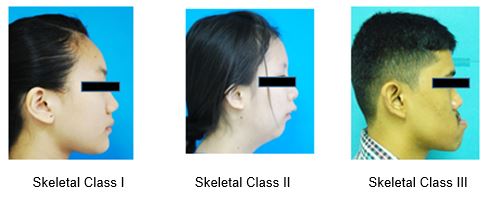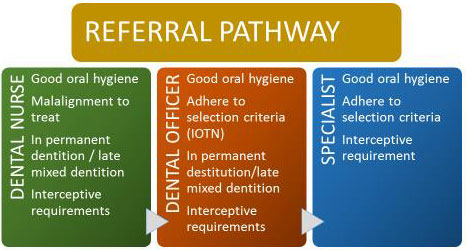What Is Orthodontics?
Orthodontics is a specialized field of dentistry that is focused on the development of the teeth and the skeletal profile. Variations in the skeletal and dental development could result in functional and aesthetic difficulties for an individual and orthodontics seeks to either intercept these variations in development stage prior to it becoming a more serious problem and also treating those that have already developed. Alignment of the teeth and normalization of skeletal profiles are the main treatment modalities used to manage a patient.
What Are The Common Problems
- Variation in teeth causing a malocclusion
The teeth erupt into the oral cavity according to their respective chronological sequence to be arranged along the jaw bone and within the soft tissue structures outside (lips and check) and inside the mouth (tongue). However due to variations in teeth and jaw size, variation in number, habits, local factors or pathology teeth can go out of their normal alignment. This results in aesthetic concerns for the individual and could also result in functional problems in more severe cases. In other instances the person could be at risk of damage to the teeth or soft tissue structure due to being prone to injury during function or unexpected accidents.
Using customized appliances these variations can be treated with good success once the main diagnosis has been done and treatment planned out.
- Variations in facial skeletal growth
Facial skeletal growth varies between individuals but in general follows a pattern and is classified as Class I, Class II or Class III skeletal growth patterns.
In a Class I growth pattern the maxilla (upper jaw) and mandible (lower jaw) are almost in a straight line when viewed from the side profile.
In a Class II growth pattern the mandible is behind the maxilla.
In a Class III growth pattern the mandible is in front of the maxilla.
This variation translates to a change in relationship between the upper and lower teeth when a person bites together resulting in either the teeth meeting together as they should (Class I) , teeth sticking out (Class II) or teeth biting in reverse (Class III). There is however some exceptions due to compensation by the surrounding tissues.
Treatment Techniques
An orthodontist treats the variations in skeletal and dental development using the following appliances and techniques that are available
- Simple removable appliances
- Fixed appliances (non-removable)
- Growth modification and interceptive treatment
- Surgical correction of severe skeletal discrepancies
- The removable appliance
Being used lesser in the current trend of treatment this device is helpful in correction of simple occlusal traits such as single tooth in cross bites or as a space maintainers. It is made of a plastic base that holds the various components that are fabricated using wires.
- The fixed appliance
The mainstay of orthodontic treatment; where complex and three dimensional tooth movement and control can be achieved using stainless steel brackets, nickel titanium wires and various auxiliaries. This device involves the use of brackets, bands, wires and elastics to permit the required tooth movement and correction.
- Growth modification and interceptive treatment
Certain features of a person’s developing dentition would be better corrected early as it would prevent it leading to more complex treatment in the future or worsening of the occlusal traits. In more severe cases there could be damage to the involved teeth and surrounding tissue structures.
Interceptive treatment is to provide early treatment for this group of patients that can range from attempts at directing the growth profile to a more favorable one or correction of one or two teeth erupting in the wrong position and then planning for comprehensive treatment once the immediate problems are solved.
- Surgical correction of severe skeletal discrepancies
Certain individuals may have skeletal profile discrepancies that are too great and no longer within the allowed limits for simple braces. These individuals require surgical correction of the underlying skeletal deformity in order to alleviate their concerns of function and aesthetic.
- Multi-disciplinary approach
In some groups of the population; dental specialist from multiple specialized fields, would pool together their efforts in managing a difficult malocclusion such as in patients with cleft lip and palate or patients with multiple missing teeth (hypodontia).
This cooperation will provide a better result as opposed to the orthodontist working alone however usually it will take more time as many discussion sessions will need to be held with both the patient and the various specialists and the orthodontist.
Prerequisite To Orthodontic Treatment
Getting orthodontic care can be a daunting task unless one knows where to go for the appropriate services.
The fastest way is to drop by your general practitioner and request for a referral to an orthodontic specialist. For school children under the incremental care program the dental nurses attending to their dental screening and care can send them to a dental officer for preliminary checkups and then further to see the specialist.
Aside from getting a referral to orthodontic specialist, to following requirements are also relevant
- Age 18 and below are the priority group for the oral health services under Ministry of Health
- Good oral hygiene with no caries or all caries restored
- Able to maintain heathy diet and follow instructions on dental care.4
- Highly motivated and able to keep to regular appointments.
References
- An introduction to Orthodontics; Third Edition. Laura Mitchell. 2007
- Contemporary Orthodontics, William R Proffit (5th Edition)
- Andrews, L F. (1972). The six keys to normal occlusion. American Journal of Orthodontics.62.296-309
- Angle E.H. (1899) Classification of Malocclusion. Dental Cosmos 41,248-64.
| Last Reviewed | : | 28 August 2020 |
| Writer / Translator | : | Dr. Puvanendran a/l Balasingam |
| Accreditor / Reviewer | : | Dr. Hjh. Rashidah bt. Dato’ Hj. Burhanuddin |









